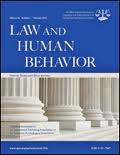 Adolescents who commit crime and misuse substances are at increased risk for subsequent crime and substance-related social problems compared to adolescents who only commit crime or who only misuse substances or who do neither. This is the bottom line of a recently published article in Law and Human Behavior. Below is a summary of the research and findings as well as a translation of this research into practice.
Adolescents who commit crime and misuse substances are at increased risk for subsequent crime and substance-related social problems compared to adolescents who only commit crime or who only misuse substances or who do neither. This is the bottom line of a recently published article in Law and Human Behavior. Below is a summary of the research and findings as well as a translation of this research into practice.
Featured Article | Law and Human Behavior | 2013, Vol. 38, No. 2, 139-150
Crime and Substance Misuse in Adjudicated Delinquent Youth: The Worst of Both Worlds
Author
Glenn D. Walters, Kutztown University
Abstract
The purpose of this study was to determine whether comorbid offending and substance misuse in previously adjudicated delinquents correlated better with measures of concurrent antisocial cognition and personality and subsequent criminality and substance misuse than offending or substance misuse alone. A sample of 1,177 youths was divided into four groups based on self-reported crime and substance misuse data from Wave 4 (ages 16–21) of the Pathways to Desistance study (Mulvey, 2012): a no-crime and substance-misuse (NCS) group, a crime-only (CO) group, a substance-misuse-only (SO) group, and a crime and substance-misuse (C&S) group. As predicted, youths in the C&S group earned significantly higher scores on concurrent measures of neuroticism, grandiosity/manipulation, callousness/ unemotionality, impulsivity/irresponsibility, and moral disengagement, and significantly lower scores on measures of agreeableness, conscientiousness, impulse control, suppression of aggression, and consideration of others than did youths in the other three groups. Prospective analyses revealed that C&S participants engaged in more subsequent crime and experienced more substance-related social problems than participants in the other three groups and reported significantly more substance-related dependency symptoms and episodes of alcohol/drug treatment than participants in the NCS and CO groups. Hence, previously adjudicated youths who experienced problems with crime and substances in late adolescence/ early adulthood were at increased risk for concurrent antisocial cognition and personality problems and subsequent crime and substance-misuse problems compared with participants in the other three groups. The prospective effects were found to be partially mediated by antisocial cognition in the form of moral disengagement.
Keywords
substance-related problems, delinquency, NEO, mediation
Summary of the Research
Data for 1,177 (1,014 male; 163 female) participants in the Pathways to Desistance study were analyzed using a multi-step data-analytic plan to determine whether “youths who engage in comorbid delinquency and substance misuse may be at greater risk for concurrent antisocial cognition/personality problems and subsequent criminal involvement/substance misuse than youths who only engage in crime or only misuse substances” (p. 139).
The Pathways to Desistance study is the largest longitudinal study of serious adolescent offenders ever completed, involving a multi-site, longitudinal study of serious adolescent offenders as they transition from adolescence into early adulthood. Between November, 2000 and January, 2003, 1,354 adjudicated youths from the juvenile and adult court systems in Maricopa County (Phoenix), Arizona (N = 654) and Philadelphia County, Pennsylvania (N = 700) were enrolled into the study. The enrolled youth were between 14 and 18 years old at the time of their offense and were found guilty of a serious offense (predominantly felonies, with a few exceptions for some misdemeanor property offenses, sexual assault, or weapons offenses). Each study participant was followed for a period of seven years past enrollment with the end result a comprehensive picture of life changes in a wide array of areas over the course of this time.
Participants were divided into 4 groups on the basis of their Wave-4 interview (which occurred approximately 24 months after their study-enrolling offense): those who endorsed no crime and no substance misuse (NCS), those who endorsed crime only (CO), those who endorsed substance misuse only (SO), and those who endorsed both criminal behavior and substance misuse (C&S). These 4 groups were then compared with respect to their scores on several dependent variables, including concurrent, prospective, and precursor variables.
The various dependent variables collected from each participant included: short-form version of the NEO Personality Inventory (NEO-PI-SF), providing scores on 5 domains including Neuroticism, Extraversion, Openness to Experience, Agreeableness, and Conscientiousness; a Moral Disengagement score; the Youth Psychopathic Traits Inventory (YPI) providing scores on 3 dimensions including Grandiose/Manipulative, Callous/Unemotional, and Impulsive/Irresponsible; the Weinberger Adjustment Inventory (WAI) designed to assess social-emotional adjustment along 2 dimensions—restraint and distress; and the Future Outlook Inventory (FOI), providing ratings of time perspective, future orientation, and overall level of goal-directedness. In addition, subsequent criminal activity and subsequent substance use problems, collected from Waves 5-10 of the Pathways study, were used as prospective dependent variables.
Participants in Wave-4 ranged from 16 to 21 years old (Mean = 18.03; SD = 1.14) and the ethnic breakdown was 21% White (n = 250), 39% Black (n = 463), 35% Hispanic (n = 410), and 5% (n = 54) from other ethnic backgrounds.
Results indicate that participants in the Crime and Substance (C&S) group “demonstrated significantly more evidence of antisocial cognition and personality than participants in the other three conditions” (p. 144). In addition, “C&S participants recorded significantly worse outcomes on all five offending measures (total offending, total offending without any drug offenses, aggressive offending, income offending, and income offending without any drug offenses) relative to CO, SO, and NCS participants. The C&S group also endorsed significantly more subsequent social consequences from substance use than participants in the other three conditions, and significantly more substance-use dependency symptoms and of alcohol/drug treatment than participants in the NCS and CO groups” (p. 144).
Translating Research into Practice
“The results of this study revealed that a group of 16-21-year-old previously adjudicated delinquents who were still committing criminal acts and experiencing substance-related difficulties 24 months after being adjudicated displayed higher levels of antisocial cognition and personality, more extensive involvement in subsequent criminal activity, and more problems with subsequent misuse of substances than previously adjudicated delinquents who engaged in only one or neither of these behaviors” (p. 146).
“Several of the cognitive/personality measures examined … may provide clues as to what may be behind the generally poor ability of C&S participants to avoid future offending and substance misuse. First, measures of negative affect (high NEO-Neuroticism), fearlessness (low NEO-Agreeableness, high Moral Disengagement, high YPI-Callousness/Unemotionality), and disinhibition (low NEO-Conscientiousness, high YPI-Impulsiveness/Irresponsibility, low WAI-Impulse Control), three temperaments viewed to be central to the formation of comorbid patterns of offending and substance misuse, were significantly more prevalent in the C&S group than in the CO and SO groups” (p. 147).
Further results disclosed the presence of a significant mediation effect attributable primarily to the Moral Disengagement variable. “Hence, we can add [Moral Disengagement]—the tendency to use cognitive strategies to justify, rationalize, and neutralize one’s own deviant and unethical behavior—to the list of cognitive variables…found to mediate the past-deviance-future-deviance relationship.” Other cognitive variables found to mediate this relationship include: criminal thinking, weak self-efficacy for conventional behavior, impulsive decision-making, physically hedonistic values, and general antisocial cognition.
“When crime and substance misuse are observed in the same individual, risk-management principles dictate that offending, substance misuse, and antisocial cognition/personality processes be targeted for intervention. This may entail reducing the negative emotionality observed in those who commit crime and misuse substances with stress- and emotion-management training, managing impulsivity and low self-control with skill-based interventions like problem solving, and challenging the mollification or neutralization patterns that mediated the subsequent offending/substance-misuse relationships in the current study with interventions directed at proactive criminal thinking styles.
Early identification of individuals at risk for future comorbid crime and substance-misuse difficulties, using temperament—negative emotionality, fearlessness, and disinhibition, in particular—as a guide may have promise as an aid to prevention and intervention. Additional research is required, however, to determine whether a temperament-based approach to prevention and intervention is effective in managing the risk presented by late adolescent/early adult individuals who exhibit comorbid patterns of crime and substance misuse” (p. 148).
Other Interesting Tidbits for Researchers and Clinicians
Researchers will be interested to read about the multi-stage data analytic strategy used in this study, including path and causal mediation analyses.
Join the Discussion
As always, please join the discussion below if you have thoughts or comments to add!







